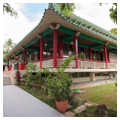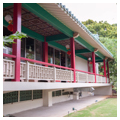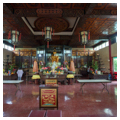A red-columned, green-tile-roofed gateway off N. Vineyard Boulevard accesses this temple dedicated to the Chinese goddess of mercy. Greeted by the scent of incense wafting in the air, visitors climb a set of stairs to a landing, make a right-angled turn, and climb another set of steps guarded by Fu dogs to reach the temple. A small brick guard house holds images of the earth deity and the deity of filial piety.
The building evokes a Chinese sensibility in a modern mode. The openness of its interior is accentuated by a wraparound lanai. A green tile, flared, hipped roof protects the main body of the building, while a green tile pent roof covers the lanai. A clerestory, surmounted by a frieze with a lotus motif, mediates the space between the two roofs. Concrete posts painted red support the roof, and ornate rafter tails mimic carved wooden forms. On the interior, a recessed eight-sided mandala centers the ceiling. A large golden statue of Kuan Yin dominates the altar area, and shrines to Wei Tor Boddhisattva, the protector and guardian of the faith, and Kuan Tai, the protector and guardian of truth and justice, are to the right and left, respectively. This building replaced an earlier temple which stood on the lot, but was demolished when N. Vineyard Boulevard was widened.







